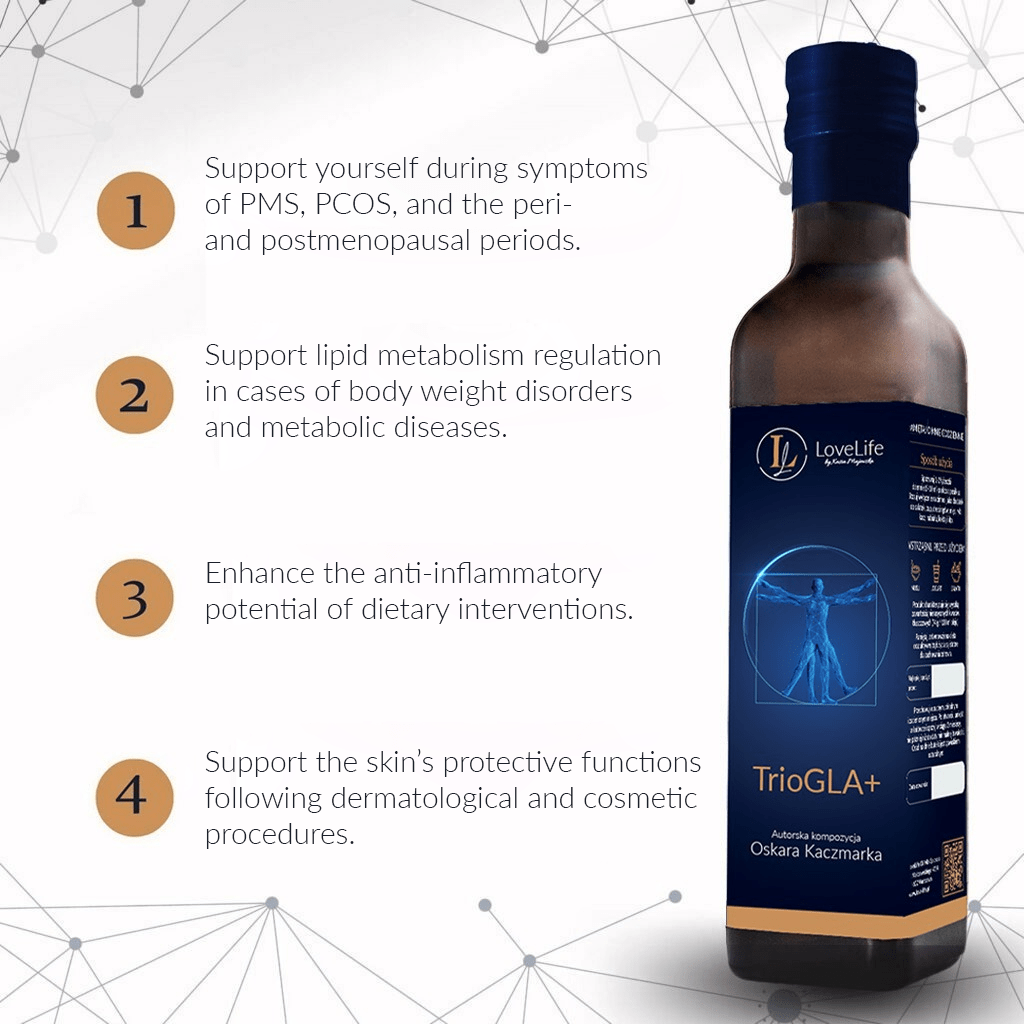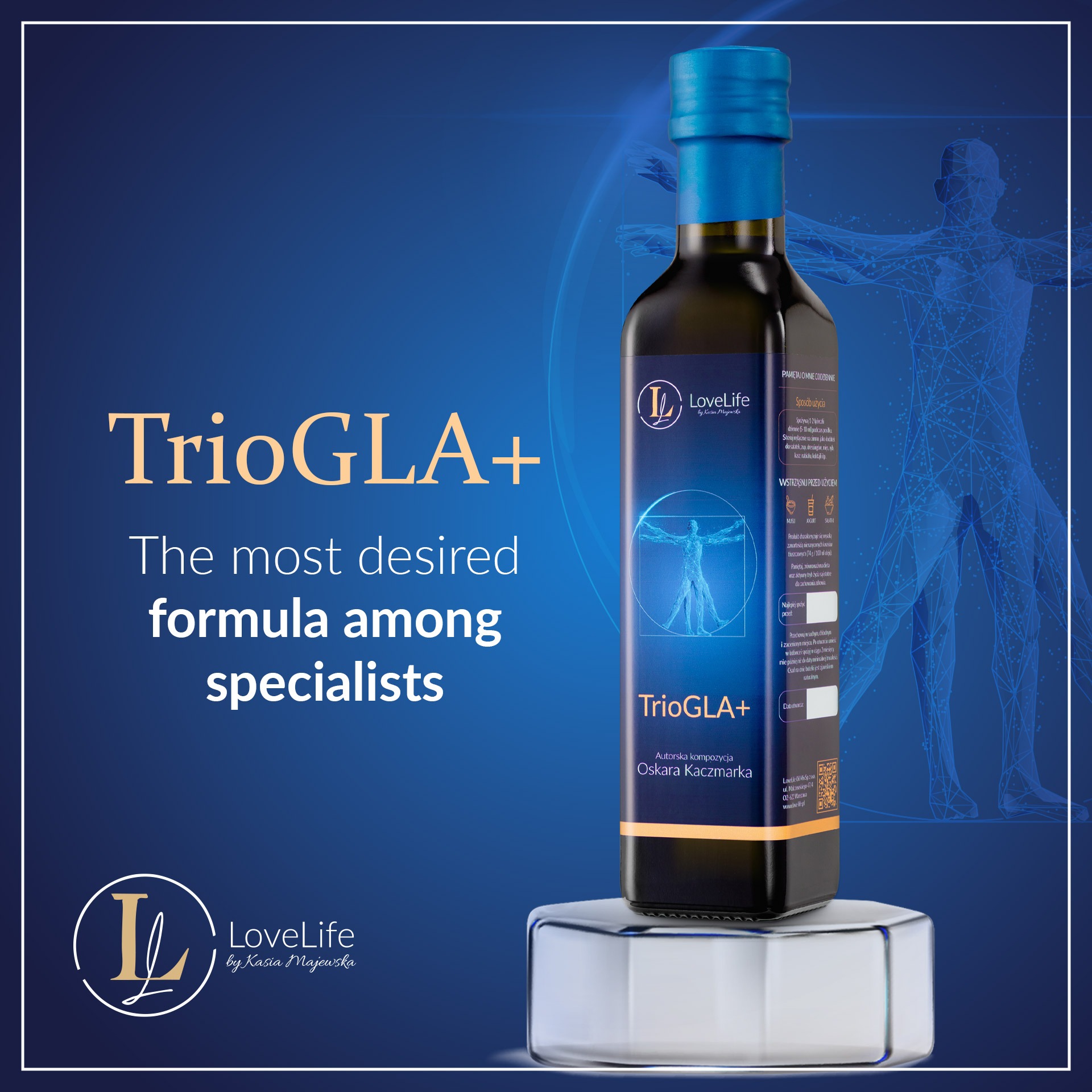
Anti-inflammatory formula

Support for women's health issues

Aid in the treatment of dermatoses

Gluten-free
Properties
How does it affect the body?
- Relieves symptoms of premenstrual syndrome (PMS) and PCOS, such as menstrual pain
- Supports the body during the perimenopausal period, reducing vaginal and skin dryness, emotional instability, and hot flashes
- Positively influences the skin’s protective functions and regeneration – helpful in skin conditions such as acne, eczema, and psoriasis
- Can be used to support skin regeneration after cosmetic and dermatological treatments
- Helps prevent the formation of atherosclerotic plaques and complications of atherosclerosis due to its strong anti-inflammatory properties
- Improves blood lipid profile, particularly by lowering triglyceride levels – an excellent complement to omega-3 DHA and EPA supplementation, enhancing the effectiveness of dietary therapy
- Can be successfully used in the treatment of rheumatoid arthritis, where its use reduces the severity of all characteristic symptoms
The product is a blend of cold-pressed oils, which are highly susceptible to oxidation due to environmental factors such as temperature and sunlight.
Depending on the production batch, the oil may vary slightly in color, taste, and cloudiness.
Use only cold! Do not expose to heat. Store in a cool, dry, and dark place. Once opened, keep refrigerated to preserve its full properties and health benefits.
For your safety: if you are under regular medical care, receiving treatment for a chronic condition, or have been diagnosed with any medical issues, it is advisable to consult your doctor before using oils.

Ingredients
Nutritional values
| Nutritional Value | 100 ml | 2 teaspoons = 10 ml |
| Energy | 3762 kJ/900 kcal | 376 kJ/90 kcal |
| Fat | 100 g | 10 g |
| saturated fatty acids | 10,94 g | 1,1 g |
| polyunsaturated fatty acids | 17,2 g | 1.7 g |
| monounsaturated fatty acids | 71,86 g | 7,2 g |
Contains negligible amounts of carbohydrates, sugars, protein, and salt.
Gamma-linolenic acid (GLA)
13,39 g / 100 g
1,3 g / 10g
The product contains a high content of unsaturated fatty acids – 89.06 g / 100 ml. Remember the importance of a balanced diet and a healthy lifestyle.
Store in a dry, cool, and shaded place. After opening, refrigerate and consume within 2 months, no later than the indicated best-before date. Sediment at the bottom of the bottle is a natural phenomenon.
Consult a doctor before using this product with blood-thinning medications.
Borage seed oil may affect the metabolism, absorption, and effectiveness of certain medications. It is especially important to monitor its use in individuals taking anticoagulants (e.g., warfarin) or antiepileptic drugs (e.g., phenytoin).
FREQUENTLY ASKED QUESTIONS
How should TrioGLA+ be stored?
To preserve the full nutritional properties and freshness of the product, we recommend storing TrioGLA+ in a cool, dry place, out of reach of children, away from sunlight and heat sources. After opening, keep the product refrigerated and consume within 2 months.
What is the recommended daily intake?
We recommend consuming 5-10 ml of the oil daily, preferably with meals served cold.
Should TrioGLA+ be taken on an empty stomach or with food?
We recommend taking TrioGLA+ only with meals.
Can TrioGLA+ be added to dishes?
TrioGLA+ can be taken on its own or added to salads, raw vegetable dishes, dressings, smoothies, and other foods served cold. THE OIL SHOULD BE CONSUMED ONLY COLD.
From what age can TrioGLA+ be taken?
TrioGLA+ in individually adjusted doses (2.5–5 ml) is suitable for children over 3 years old.
Can pregnant or breastfeeding women take TrioGLA+?
Pregnant and breastfeeding women should consult a doctor before using the product.
Can TrioGLA+ be overdosed?
As a food product, TrioGLA+ has no strict usage guidelines and does not pose a risk of overdose.
Should breaks be taken during TrioGLA+ consumption?
It is recommended to incorporate TrioGLA+ as a regular part of the diet without the need for breaks. In case of doubt, we always advise consulting a specialist who can assess whether continuing the product at the current dose is appropriate.
REVIEWS
LoveLife TrioGLA+ by Doctor Mikrobiom
To już kolejna butelka tego niezwykłego eliksiru, która odmieniła moje życie. Cudownie działa na mój organizm. PMS - brak, ból miesiączkowy - do zniesienia, znikomy lub wcale. Wcześniej miesiączka kasowała mi 2 dni z życia. Teraz jak ręką odjął, nawet nie wiem, że się zaczyna! Kupcie sobie dziewczyny, bo to naprawdę super produkt. Cena adekwatna do działania. P.S. Od kiedy nie jem słodyczy ma super wyczulony zmysł smaku i mogłabym ten olej wypić duszkiem z butelki :)
LoveLife TrioGLA+ by Doctor Mikrobiom
Produkt godny polecenia.
LoveLife TrioGLA+ by Doctor Mikrobiom
Mam endometrioze i w zeszłym roku borykałam się z nawrotem choroby, ciągłymi torbielami, wizytami na sorze, bólem itd... zaczęlam pić olej w czerwcu i od tamtej pory się z nim nie rozstaje ;) brak torbieli, ból zminimalizowany do lekkiego dyskomfortu podczas owulacji i okresu, sam okres, który zalewał mnie zawsze- jest normalniejszy ;) ginekolog na kontrolnej wizycie powiedział, że nie pamięta kiedy moje usg tak dobrze wyglądało ;) uwielbiam ten olej !
LoveLife TrioGLA+ by Doctor Mikrobiom
Jestem bardzo zadowolona z produktu, to moja koleżanka butelka. Jest wspaniały, super działa na okres, ale też na skórę🥰 przy AZS jest nieoceniony. Czuję ogromną poprawę. Pozdrawiam i z pewnością zamówię kolejną butelkę, Klaudia. ❤️
Bibliography
- Duraj, K., & Palacz-Wróbel, M. (2021). Multi-directional effect of primrose oil on organism. Medycyna Rodzinna.
- Jopkiewicz, S. Tłuszcze i oleje roślinne. PROBLEMY NAUK MEDYCZNYCH I NAUK O ZDROWIU, 47. Exante Wydawnictwo Naukowe, Wrocław 2018
- Kawamura, Asuka, et al. „Dietary supplementation of gamma-linolenic acid improves skin parameters in subjects with dry skin and mild atopic dermatitis.” Journal of oleo Science12 (2011): 597-607.
- Kaźmierska, A., Gawor, E. (2015). Wpływ oleju z wiesiołka na skórę, ze szczególnym uwzględnieniem działania kwasu gamma-linolenowego (GLA). Kosmetol. Estet., 4, 4, 335–338.
- Materac E, Marczyński Z, Bodek KH: Rola kwasów tłuszczowych omega-3 i omega-6 w organizmie człowieka. Bromat Chem Toksykol 2013; XLVI: 225-233.
- Muggli R. Systemic efening primrose oil improves the biophysical skin paraweters of health adults. Int J Cosmet. Sei 2005; 27(4) 243– 249.
- Nowak A.; Popko M.; Klimowicz A.: Preparaty pochodzenia roślinnego w pielęgnacji skóry u chorych z łuszczycą. Postępy Fitoterapii, 2016, 4: 332-337.
- Querques G, Russo V, Barone A, et al. Efficacy of omega-6 essential fatty acid treatment before and after photorefractive keratectomy. J Fr Ophtalmol. 2008;31:282-286.
- van Gool CJ, Thijs C, Henquet CJ, et al. Gamma-linolenic acid supplementation for prophylaxis of atopic dermatitis – a randomized controlled trial in infants at high familial risk. Am J Clin Nutr 2003:77:943-951.
- Veselinovic, Mirjana, et al. „Clinical benefits of n-3 PUFA and ɤ-linolenic acid in patients with rheumatoid arthritis.” Nutrients4 (2017): 325.
- von Schacky C. n-3 fatty acids and the prevention of coronary atherosclerosis. Am JClin Nutr 2000;71:224S-227S
- Winiarska-Mieczan A, Samolińska W, Kowalczuk-Vasilev E, eds. Czynniki żywieniowe a stan skóry, włosów i paznokci. Fizjologia, dietoterapia, suplementy diety, bezpieczeństwo i skuteczność terapii, toksykologia. Lublin: Wyd. UP w Lublinie; 2022.
